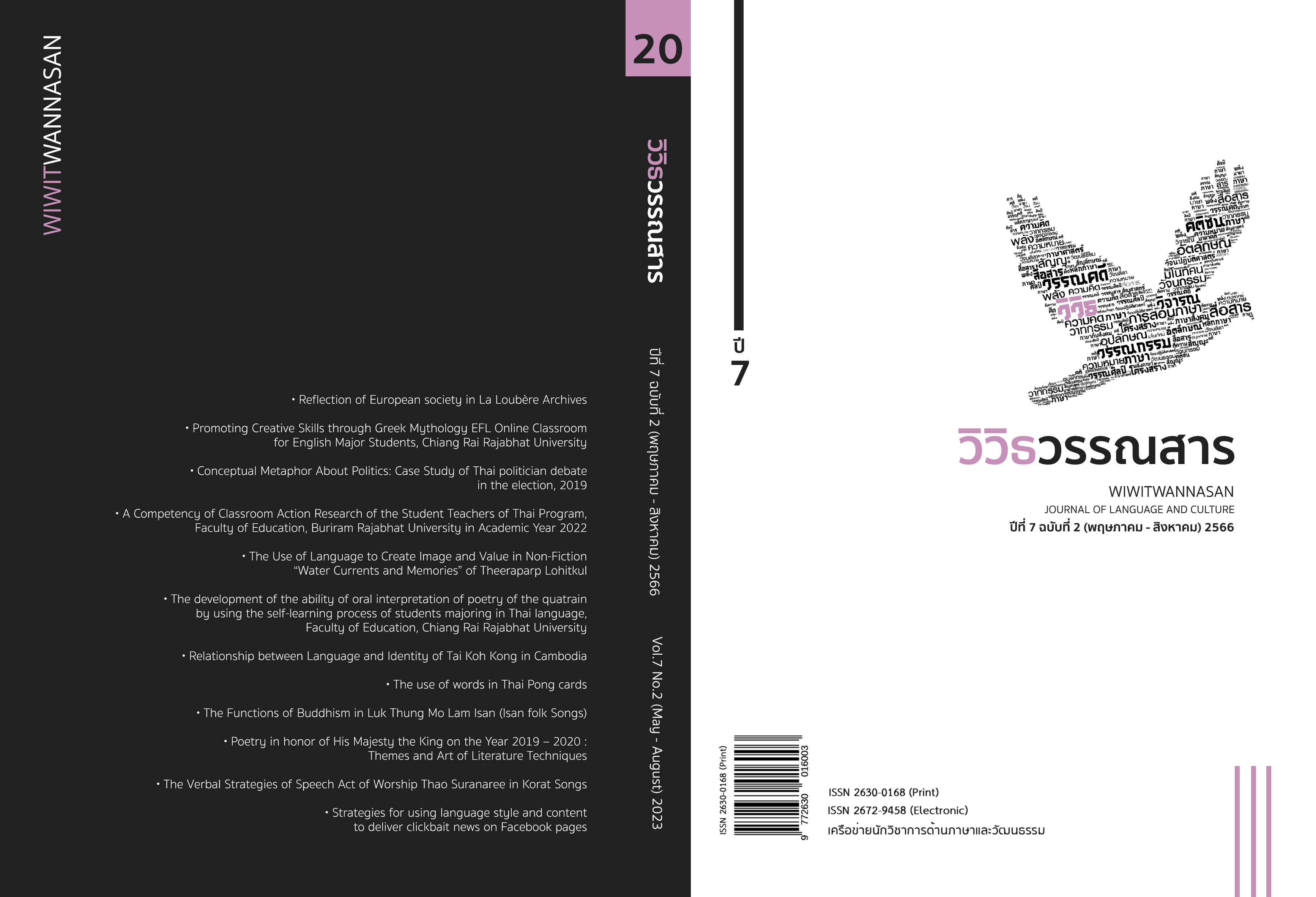บทบาทหน้าที่ของสิ่งศักดิ์สิทธิ์ในเพลงลูกทุ่งหมอลำอีสาน
Main Article Content
บทคัดย่อ
บทคัดย่อ
วัตถุประสงค์ของบทความวิจัยนี้ คือ เพื่อศึกษาบทบาทหน้าที่ของสิ่งศักดิ์สิทธิ์ที่ปรากฏในเพลงลูกทุ่งหมอลำอีสานจำนวน 43 เพลง จากการเผยแพร่ในโปรแกรมยูทูบระหว่างปี พ.ศ. 2550-2565 โดยใช้แนวคิดบทบาทหน้าที่ทางคติชนวิทยา และใช้ระเบียบวิธีวิจัยเชิงคุณภาพ
ผลการศึกษาและวิเคราะห์ข้อมูลพบว่า (1) สิ่งศักดิ์สิทธิ์มีบทบาทหน้าที่สำคัญต่อการสร้างกำลังใจให้กับผู้ฟังทั้งในสถานการณ์จริงและในเพลงลูกทุ่งหมอลำอีสาน (2) สิ่งศักดิ์สิทธิ์มีบทบาทหน้าที่ในการอำนวยพรให้ผู้ขอพรสำเร็จด้านความรัก ความสำเร็จในการเป็นศิลปินนักร้อง การงาน การเงิน โชคลาภ ซึ่งแนวคิดเช่นนี้มีความใกล้เคียงกับการร้องขอคำอำนวยพรเทพเจ้าและสิ่งศักดิ์สิทธิ์ในหลายวัฒนธรรมศาสนา (3) บทบาทหน้าที่ของสิ่งศักดิ์สิทธิ์ในเพลงลุกทุ่งหมอลำอีสานสะท้อนระบบความเชื่อที่สอดคล้องกันระหว่างสังคมวัฒนธรรมอีสานกับความเชื่อในเพลง กล่าวคือ ชาวอีสานมีความเชื่อและนับถือผี พระพุทธศาสนา พญานาค ตัวละครจากชาดกนอกนิบาต พญาแถน เจ้าพ่อมเหศักดิ์หลักเมือง เป็นต้น (4) สิ่งศักดิ์สิทธิ์ที่ปรากฏในเพลงลูกทุ่งอีสานมีความเชื่อมโยงกับความเชื่อของผู้คนในสังคมอีสานส่วนใหญ่ และมีบทบาทหน้าที่ต่อการประพันธ์เพลงลูกทุ่งหมอลำอีสาน 5) สิ่งศักดิ์สิทธิ์ที่ได้รับการร้องขอมากที่สุดได้แก่ กลุ่มผีเจ้าพ่อและเจ้าเมืองที่ผู้คนเคารพนับถือ พญานาค ผีเจ้าแม่ เทพเจ้าและยักษ์ ตัวละครจากวรรณกรรมอีสาน ผีไท้และพญาแถน และทั่วไปมีนางกวัก, ท้าวสุรนารี, ผีตาแฮก, พระมหากษัตริย์ไทย-ในหลวงรัชกาลที่ 9, พญาเต่างอย, แม่ย่าซอม, ขวัญ, น้ำมันพราย –ดินเจ็ดผีป่าช้า
บทบาทหน้าที่ของสิ่งศักดิ์สิทธิ์ในเพลงลุกทุ่งหมอลำอีสานแสดงว่า เพลงลักษณะดังกล่าวเป็นการใช้เสียงเชิงพิธีกรรม ถ้อยคำสื่อถึงสิ่งศักดิ์สิทธิ์ผ่านบทเพลงเป็นกระบวนการเดียวกับพิธีกรรมการสรรเสริญขอพรเทพเจ้า และการแต่งคัมภีร์บาลีชั้นอรรถกถาเป็นต้นมา สิ่งศักดิ์สิทธิ์จึงมีบทบาทหน้าที่ทำให้เพลงเช่นนี้เป็นความบันเทิงเชิงพิธีกรรมสำหรับปัดเป่าความทุกข์ทางใจ คือเพื่อเป็นการเสริมกำลังใจให้ทั้งผู้ร้องและผู้ฟังนั่นเอง
คำสำคัญ: บทบาทหน้าที่, สิ่งศักดิ์สิทธิ์, ลูกทุ่งหมอลำอีสาน
Article Details

อนุญาตภายใต้เงื่อนไข Creative Commons Attribution-NonCommercial-NoDerivatives 4.0 International License.
ลิขสิทธิ์ของบทความเป็นของวารสาร การพิมพ์ซ้ำจะต้องได้ร้บการอนุญาตจากบรรณาธิการวารสาร
เอกสารอ้างอิง
Anuman ratchathon, phraya. (1988). muat prawattisat borankhadi rueang khong chatthai [Archeology History Division the story of the Thai nation]. Bangkok : Ladprao Teachers' Council Printing House.
Ariyanuwat, Phra. (1970). Phaya Khan Khak [The King of toads]. Maha Sarakham: Northeastern Literature Conservation Center.
Ariyanuwat, Phra. (1993). Botkhwam “khati khwamchuea khong chao isan” Article “Beliefs of the Northeastern People” in Duke P. and others. (editor.). watthanatham phuenban : khati khwamchuea [folk culture : beliefs] (p. 15). Bangkok: Chulalongkorn University.
Kasetthat. P. (2015). Bueanglang Rup Khaorop Khati Khwamchuea Rup Thaen Bukkhon Nai Sayam [Behind the idol Belief in images representing people in Siam]. Bangkok: Matichon.
Nathalang, S. (2009). chonchat thai nai nithan : lae lot waen khati chon lae wannakam phuenban [Thai race in the novel : looking through folklore glasses and folk literature]. Bangkok: Matichon.
Nathalang, S. (2009). Thruesadi Khati Chon Witthaya: Withi Witthaya Nai Kan Wikhro Tamnan Nithan Phuenban [Folklore theory : a mythological method of analyzing myths, folk tales]. Bangkok: Chulalongkorn University.
Pitathawatchai, W. (1973). Hit Sip Song [The twelve annual Isan merit-making Traditions]. Bangkok: Mahachon.
Prachakitkonchak , phraya. (1926). Tamnanyonok [The legend of Yonok]. N.P. : Bandittayasapha.
Sinlapakon, krom. (1984). sila charuek sukhothai lak thi 2 [The 2nd main Sukhothai stone inscription]. Bangkok : United Printing Press Productions.
Sinlapakon, krom. (2009). saranukrom prapheni thai prapheni rat lem 3 ( khati khwamchuea) [Encyclopedia of Thai traditions People's traditions, volume 3 (beliefs)]. Bangkok : Advance Vision Service.
Sinlapakon, krom. (2021). ekkasan sadet truat ratchakan senabodi krasuang mahatthai ro so 119-131 [official document Chancellor of the Ministry of
Interior R.E. (1900 - 1912)]. Bangkok : Amarin Printing and Publishing.
Somchai, S. Phramaha. (1995). Lak Tham Thang Phra Phut Sa Na Thi Prakot Nai Botphleng Luk Thung Thai [Buddhist Dharma Principles Appeared in Thai Luk Thung Songs]. Bangkok: Mahachulalongkornrajavidyalaya University.
Yaen chong, J. (2005). Khon Thai Mai Chai Khon Thai Tae Pen Khruea Yat Chat Phasa [“Khon Tai” is not “Thai people” but is a kinship of nationality, language]. Bangkok: Matichon.


